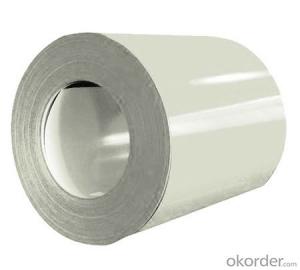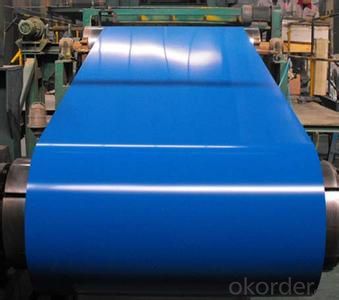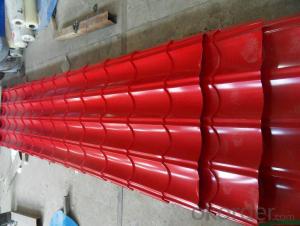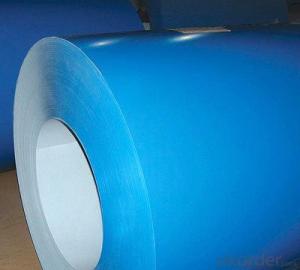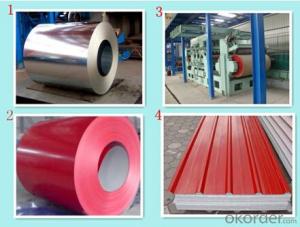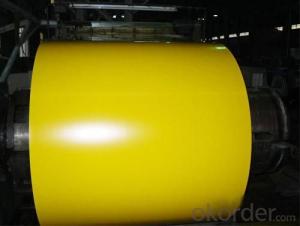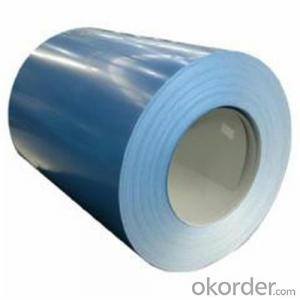Prepainted Galvanized Steel Coil Good Quality for Roofing-CGCC
- Loading Port:
- China main port
- Payment Terms:
- TT or LC
- Min Order Qty:
- 50 m.t.
- Supply Capability:
- 15000 m.t./month
OKorder Service Pledge
OKorder Financial Service
You Might Also Like
Prepainted Galvanized Steel Coil Good Quality for Roofing-CGCC
1. Structure of Prepainted Galvanized steel Coil :
•Prepainted galvanized steel qualified with excellent decorative ,formability ,corrosion resistance ,coating adhesion ,can keep for a long time as well as maintain fresh color .For color coated steel sheet can obtain good economic benefit by steel belt wood ,efficient in construction and save energy ,prevent pollution etc. Which is an ideal material for manufacturing board.
2.Main Features of Prepainted Galvanized steel Coil:
• Excellent process capability
• Smooth and flat surface
• Workability, durability
• Excellent heat resistance performance
• High strength
• Good formability
• Good visual effect
3.Prepainted Galvanized steel Coil Images
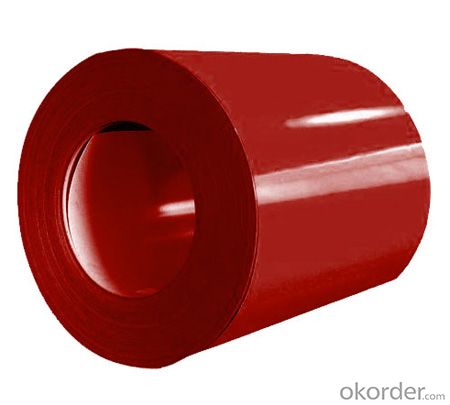
4.Prepainted Galvanized steel Coil Specification
Standard: ASTM, GB,JIS,JIS G3302 ASTM 755 EN10169
Grade: DX51D CGCC CS
Thickness: 0.2mm~1.2mm,
Width: 600-1250mm
Coil weight:3-12 MT
Coil ID:508/610mm
5.FAQ of Prepainted Galvanized steel Coil
We have organized several common questions for our clients,may help you sincerely:
1.How do you control your quality
We have established the international advanced quality management system,every link from raw material to final product we have strict quality test;We resolutely put an end to unqualified products flowing into the market. At the same time, we will provide necessary follow-up service assurance.
2.How long we will receive the goods ?
After receiving your deposit or workable lc ,our normal shipment date is 15-20days,and it takes around 28 days to reach your port of destination. But is up to different destination
3. What is your moq
Normally our moq is 25per size ,but it is up to different size
- Q: How are steel coils used in the manufacturing of construction scaffolding?
- Steel coils are used in the manufacturing of construction scaffolding as they provide the necessary strength and durability required for the structures. These coils are generally processed and shaped into various components, such as pipes, tubes, and frames, which form the main structure of the scaffolding. The high tensile strength of steel coils ensures that the scaffolding can support heavy loads and provide a safe working platform for workers at construction sites.
- Q: We just installed a stainless steel electric stove, what is the best way to keep it clean and shiney?
- Contact a sanitary supply company for a product to maintain stainless steel.
- Q: How are steel coils used in the production of roofing systems?
- Steel coils are used in the production of roofing systems in various ways. Firstly, the steel coils are unrolled and fed into a machine where they are cut to the desired length for the roofing panels. These coils are often made of galvanized steel, which is coated with a layer of zinc to protect against rust and corrosion. Once the coils are cut, they are then passed through a roll-forming machine. This machine shapes the steel into the required profile for the roofing panels. The shape of the panels can vary depending on the design and functionality of the roofing system. After the steel is formed, it may undergo further processes such as embossing or stamping to add texture or patterns to the panels. This helps to enhance the aesthetics of the roofing system and provide a unique look. The formed and processed steel panels are then coated with additional protective layers or finishes, such as paint or polymer coatings. These coatings further enhance the durability of the roofing system and provide resistance against weather elements, UV rays, and corrosion. The final step in the production of roofing systems involves the installation of the steel panels on the roof. The panels are typically fastened to the roof structure using screws or nails. The interlocking design of the panels ensures a secure and watertight installation, providing protection against leaks and moisture infiltration. Overall, steel coils play a crucial role in the production of roofing systems by providing a durable and long-lasting material that can withstand harsh environmental conditions. The versatility of steel allows for various design options and customization, making it a popular choice for roofing applications.
- Q: I need to know how you rate the hardness of steel any ideas?
- For the backyarder to rate hardness, you do a file test. If a smooth file will not mark the steel, it's around 60+RC (Rockwell C scale). If it will mark it with difficulty, the hardness is probably around 56- 58RC. If it will file easily, it's mild steel or is in annealed form, if it is a hardenable steel.
- Q: Correct me if I am wrong, but steel is an alloy between iron and carbon. Does the carbon in the steel stops the iron from rusting or corroding? Also what is the difference between mild steel and stainless steel?
- Mild steel is an alloy. It is the most common form of steel. Mild steel (a so-called carbon steel) is a general term for a range of low carbon (a maximum of about 0.3%) steels that have good strength and can be bent, worked or can be welded into an endless variety of shapes for uses from vehicles (like cars and ships) to building materials. The carbon does not stop the material rusting or corroding. In addition to iron, carbon, and chromium, modern stainless steel may also contain other elements, such as nickel, niobium, molybdenum, and titanium. Nickel, molybdenum, niobium, and chromium enhance the corrosion resistance of stainless steel. It is the addition of a minimum of 12% chromium to the steel that makes it resist rust, or stain 'less' than other types of steel. The chromium in the steel combines with oxygen in the atmosphere to form a thin, invisible layer of chrome-containing oxide, called the passive film. The sizes of chromium atoms and their oxides are similar, so they pack neatly together on the surface of the metal, forming a stable layer only a few atoms thick. If the metal is cut or scratched and the passive film is disrupted, more oxide will quickly form and recover the exposed surface, protecting it from oxidative corrosion.
- Q: How are steel coils processed?
- Steel coils are processed through a series of steps, including cleaning, pickling, cold rolling, annealing, and tempering. These processes help to remove impurities, improve surface finish, reduce thickness, and enhance mechanical properties of the steel coils.
- Q: Does a magnet stick to galvinied steel?
- It may have been galvanized steel but if it is now rusted, the galvanizing material has been consumed. galvanizing is a zinc layer that can be hazardous if welded. Rust is an electrochemical reaction and the zinc coating will rust away prior to the steel. if the steel is now rusting, the zinc is gone and should no longer be any more hazardous than any other welding job.
- Q: How are steel coils used in the production of automotive chassis?
- Steel coils are used in the production of automotive chassis by being processed into flat sheets, which are then cut, shaped, and welded to form the structural framework of a vehicle. The high strength and durability of steel make it an ideal material for chassis construction, providing stability and protection to the vehicle's occupants.
- Q: Are steel coils used in appliances manufacturing?
- Yes, steel coils are commonly used in appliances manufacturing. They are widely used for constructing the frames, cabinets, and other structural components of various appliances such as refrigerators, washing machines, dishwashers, and ovens. Steel coils provide strength, durability, and stability to these appliances, making them an essential component in their manufacturing process.
- Q: What are the factors that affect the quality of steel coils?
- The quality of steel coils can be influenced by various factors. To begin with, the composition of the steel itself plays a vital role in determining its quality. Impurities like sulfur or phosphorus can have a negative impact on the strength, durability, and overall performance of the steel. Additionally, the quality of the steel is affected by its carbon content, alloying elements, and heat treatment. Furthermore, the quality of the steel coils is greatly affected by the manufacturing process and techniques utilized during production. Factors such as the cleanliness of the production environment, the precision of the rolling and cooling processes, and the control of temperature and pressure throughout manufacturing all contribute to the final quality of the coils. Additionally, the surface quality of the steel coils is a crucial factor. Any defects or imperfections on the surface, such as scratches, dents, or corrosion, can compromise the integrity and functionality of the coils. It is essential to handle, store, and transport the coils properly to maintain their surface quality. Moreover, the mechanical properties of the steel coils, including tensile strength, yield strength, and elongation, are essential indicators of their quality. These properties depend on various factors, such as the type of steel, its thickness, and the processing conditions. Lastly, external factors such as environmental conditions, like humidity and temperature, can affect the quality of steel coils. Exposure to moisture or extreme temperatures can lead to corrosion or other forms of degradation, impacting the overall quality and lifespan of the coils. In conclusion, the quality of steel coils is influenced by several factors, encompassing the composition of the steel, the manufacturing process, surface quality, mechanical properties, and external environmental conditions. It is crucial to carefully control and monitor these factors to produce high-quality steel coils that meet the desired specifications and standards.
Send your message to us
Prepainted Galvanized Steel Coil Good Quality for Roofing-CGCC
- Loading Port:
- China main port
- Payment Terms:
- TT or LC
- Min Order Qty:
- 50 m.t.
- Supply Capability:
- 15000 m.t./month
OKorder Service Pledge
OKorder Financial Service
Similar products
Hot products
Hot Searches
Related keywords


